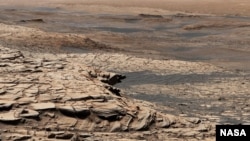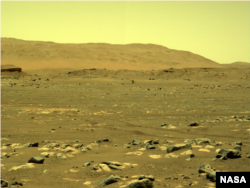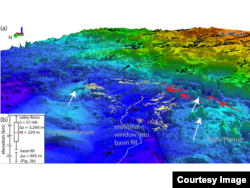Researchers say they have discovered new evidence that Mars once had a large northern ocean. The finding adds to existing evidence that ancient Mars had the right conditions to possibly support some form of life.
Today, Mars has a cold, desert climate. Any water is believed to be in the form of ice because of the planet’s extremely cold temperatures. But there is a rich amount of evidence suggesting that rivers, lakes and even oceans once existed on Mars.
For example, a 2015 study by the American space agency NASA suggested that 4.3 billion years ago, Mars likely had an ocean that covered nearly half of Mars’ northern hemisphere.
Another NASA-supported study, published in January, estimated that three billion years ago, the climate in much of the planet’s northern hemisphere was very similar to present day Earth. The study noted that at the time, Mars likely had a much thicker atmosphere than today and had an active, northern ocean.
Now, two American researchers have released a set of maps they say provides new environmental evidence of a large ancient ocean on Mars’ low-lying northern hemisphere.
The team collected data from satellite images of Mars. They then combined these images to create topography maps of the planet’s northern hemisphere.
Using these maps, the researchers said they were able to piece together evidence of shorelines that sat at the edge of a huge body of water about three-and-a-half billion years ago.
The scientists recently published their findings in the Journal of Geophysical Research: Planets.
The team said it used software developed by the United States Geological Survey to map data collected by spacecraft operated by NASA. The research uncovered more than 6,500 kilometers of ridges that are believed to have been formed by flowing water.
The scientists say the ridges likely represent the leftover evidence of eroded river systems and an ancient ocean floor. The team said its research also suggested large levels of sediment, providing further evidence of a large ocean.
Benjamin Cardenas was a co-writer of the study. He is a professor of geosciences at Penn State University in Pennsylvania. He said in a statement the area of Mars studied – now known as Aeolis Dorsa – contains “the densest collection” of water-formed ridges on the planet.
Cardenas said the study’s findings demonstrate the possible ocean in that area of Mars was very active and interesting. “It was dynamic. The sea level rose significantly,” he said. “Rocks were being deposited along its basins at a fast rate. There was a lot of change happening here.”
Cardenas added that areas on our own planet containing water-formed ridges and sediment provide researchers with much useful information about an area’s climate and life forms. “If scientists want to find a record of life on Mars, an ocean as big as the one that once covered Aeolis Dorsa would be the most logical place to start,” he said.
The team noted that the major goal of NASA’s Mars explorer, Curiosity, is to look for signs of ancient life on the planet. Currently, Curiosity is operating within the planet’s Gale Crater, which is in the southern hemisphere of Mars. In the past, researchers have also found evidence of past water systems around Gale Crater.
In addition to providing more evidence of a large ocean, Cardenas suggested the new study also provides useful information on Mars’ ancient climate and developmental history. “Based on these findings, we know there had to have been a period when it was warm enough and the atmosphere was thick enough to support this much liquid water at one time,” he said.
I’m Bryan Lynn.
Bryan Lynn wrote this story for VOA Learning English, based on reports from Penn State, NASA the Journal of Geophysical Research: Planets and Arizona State University.
___________________________________________________________________
Words in This Story
topography – n. the shape and other physical characteristics of a piece of land
shoreline – n. the edge of a sea, lake or wide river
ridge – n. a long, narrow piece of land
erode – v. to rub away over time
sediment – n. the material that sinks to the bottom of a liquid
dynamic – adj. continuously changing or developing
deposit – v. to leave something somewhere
logical – adj. reasonable and based on good judgment
______________________________________________________________________
What do you think of this story? We want to hear from you. We have a new comment system. Here is how it works:
- Write your comment in the box.
- Under the box, you can see four images for social media accounts. They are for Disqus, Facebook, Twitter and Google.
- Click on one image and a box appears. Enter the login for your social media account. Or you may create one on the Disqus system. It is the blue circle with “D” on it. It is free.
- Each time you return to comment on the Learning English site, you can use your account and see your comments and replies to them. Our comment policy is here.














Forum